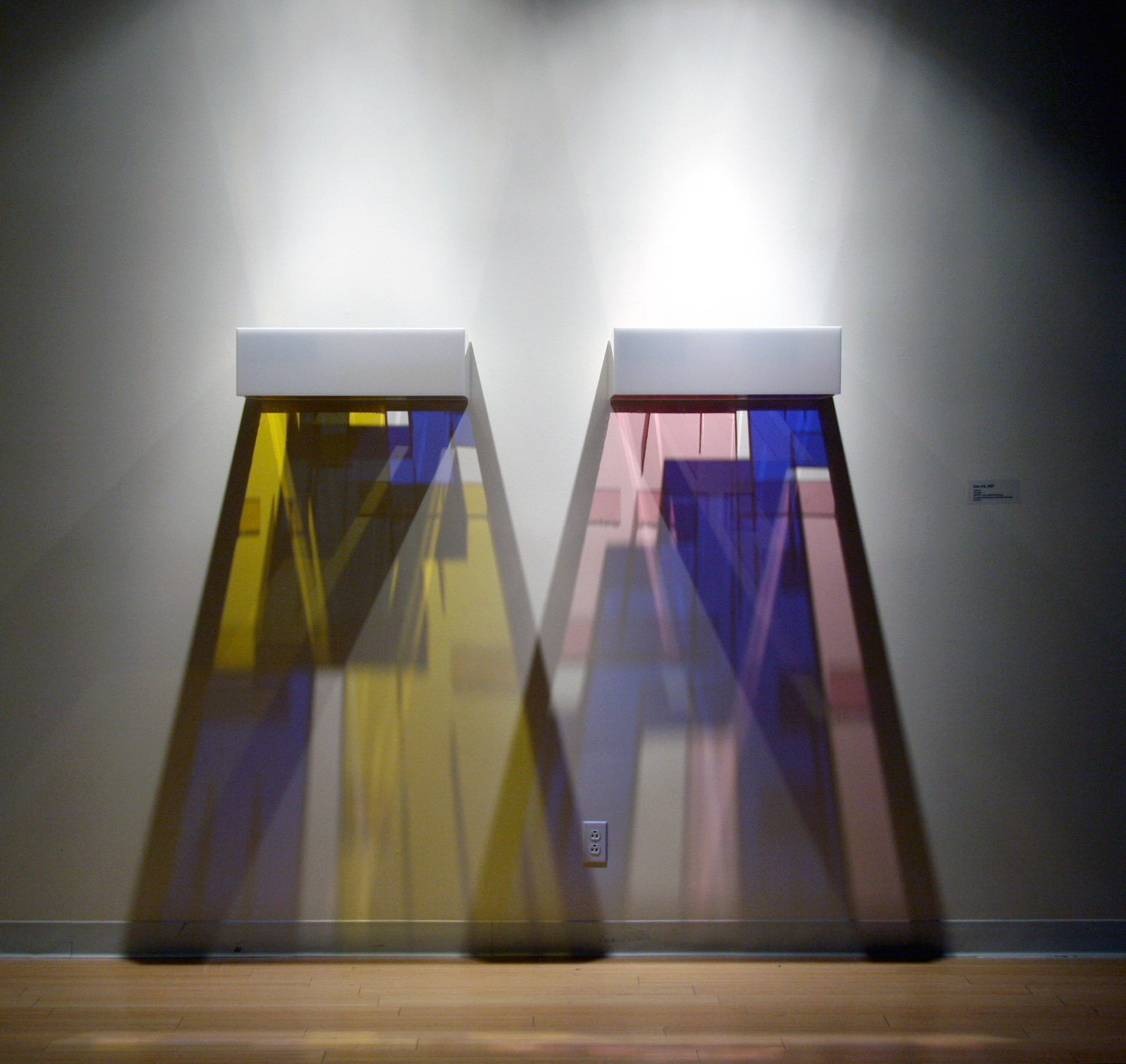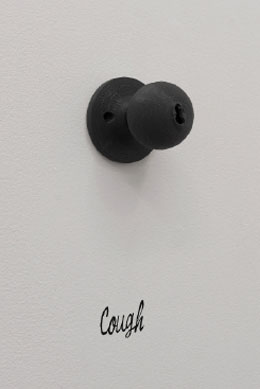A Language of Time and Space
Sculptor Won Ju Lim draws on architecture to create futuristic, cinematic worlds
By Mara Sassoon | Photo by Johnna Arnold/JKA Photography
Won Ju Lim says her work is never really complete; her multimedia installations are altered in unexpected ways whenever they move to a new place. “The architectural location—the space, the height of the ceiling, the geographic location, the lighting—these factors all make a difference,” says Lim, an assistant professor of sculpture at CFA. Mutability is essential to her work, which explores the relationships between people, objects, space, and time.
One of the pieces that has morphed as it’s been displayed in different venues is California Dreamin’ (2002/2018), which Lim created while living in Germany and feeling homesick for Los Angeles, where she grew up. The piece is comprised of more than 100 luminous plexiglass and foam-core board structures in shades of blue, green, and yellow that look like stacked Tetris pieces. Lim based the structures on floor plans from old do-it-yourself home catalogs. The installation also incorporates videos and still image projections of distinctive California scenery: palm trees, sunsets, boxy architecture.

California Dreamin’, 2002/2018. Plexiglass, foam-core board, lamps, three video projections. Exhibition view at San José Museum of Art. Photo by Johnna Arnold/JKA Photography
First shown in 2002, the installation was recently acquired by the San José Museum of Art (SJMA), where it was the centerpiece of the 2018 exhibition Won Ju Lim: California Dreamin’. There, the piece took on new meaning: it had returned to its geographic roots, transforming a dreamscape influenced by homesickness into an idyllic vision of Hollywood. California Dreamin’ was installed in a vast, dimly lit room, where its structures were amassed into an island, their jewel tones picking up light from three videos projected on the gallery walls. The island motif was inspired in part by Lim’s interest in the origins of her home state’s name, which can be traced to the fantastical 1510 Spanish chivalric romance novel Las Sergas de Esplandián by Garci Rodríguez de Montalvo. The state was named after the book’s paradisiacal island made of gold and its ruler, Queen Calafia, Lim says.
California Dreamin’ was also heavily influenced by the style of science fiction films like Blade Runner and Metropolis. “The aesthetics of the cityscapes shown in these films are from decades ago, yet they remain futuristic; they suggest a superimposition of the future and the past, suspending the present,” Lim says. Cast in the cinematic glow of the surrounding videos, California Dreamin’ could be a set model for one of those films.
“My ambition was, and still is, to carry on my interest and knowledge in architecture without the confinements and limitations architects often confront.”
Won Ju Lim
Lim’s background in architecture is palpable in many of her works. Born in South Korea, she earned a BS in architecture from Woodbury University in Burbank, Calif., and an MFA from the Art Center College of Design in Pasadena, and worked at architectural and design firms prior to becoming a studio artist.
“The issue of practicality inherent in architecture can be explored and questioned in making art,” she says. “My ambition was, and still is, to carry on my interest and knowledge in architecture without the confinements and limitations architects often confront.
“As an artist, I do not feel obligated to answer or solve practical issues concerning space, but I do feel the need to expose and explore our psychological and phenomenological relationships to space.” She does this by playing with scale, focusing on interior and exterior relationships, and considering the interactions between people and her art.
Her mixed media sculpture A Piece of Echo Park (2007), for example, which was on display in the California Dreamin’ exhibition, is a miniature topographic model of a hilly formation dotted with tiny trees and houses, contained inside a yellow plexiglass box. One side of the sculpture is covered in what looks like grass and shrubs, the other side reveals exposed plaster patchily covered in splotches of neon pink, green, and orange paint. By containing the structure in a bright yellow box, Lim places the viewer on the outside looking in at this diminutive world.
Lim’s Kiss 7 (2005) contains plexiglass models of the Los Angeles Case Study Houses (experimental homes built by renowned architects in the ’40s, ’50s, and ’60s) in wall-mounted boxes. Kiss 7 highlights a sense of changeability; any variation in light or human interference alters the installation.
For her current project, Aunt Clara’s Dilemma, Lim was inspired by the way characters travel through space in the television show Bewitched. She became fascinated with the way the witches in the ’60s sitcom pass through doors and walls, and is particularly intrigued by Aunt Clara, an elderly witch whose powers become increasingly erratic.
“Unable to clear the hurdle of the door, Aunt Clara becomes a fetishistic collector of doorknobs,” Lim says.
Aunt Clara’s Dilemma is composed of 3-D-printed doorknobs twisted into animated representations of bodily functions; one is evocative of a sneeze, another a cough. Lim plays off of Aunt Clara’s obsession and imbues the doorknobs with human characteristics to represent the division of space and how people move from one place to another within it.
“Space is a word that makes something of the nothing that surrounds us,” Lim says in her artist statement about the piece. “I see Aunt Clara’s Dilemma as a body of work about doorknobs, thresholds, and the moment when the old dialectic of outsides and insides becomes a mise-en-abyme,” embedding a copy of an image inside the image itself (such as a portrait of an artist holding that same portrait).
With Aunt Clara’s Dilemma, as in all of her installations, Lim says, “tangible things such as plexiglass, wood, and resin are merely vehicles that carry a specific language of time and space.”

Kiss 7, 2005. Plexiglass, lamp, shadow, 7 x 24 x 17 inches. Courtesy of Won Ju Lim

Kiss 4, 2007. Plexiglass, lamp, shadow, 7 x 60 x 17 inches. Courtesy of Won Ju Lim

Memory Palace, Terrace 49 #1, 2003. Anodized aluminum box, frosted Mylar, LED lights, mixed media sculpture, 42 x 42 x 20 inches. Courtesy of Won Ju Lim

A Piece of Echo Park, 2007. Mixed media sculpture in plexiglass box,
38 x 45 x 38 inches. Exhibition view at San José Museum of Art. Johnna Arnold/JKA Photography

Cough, 2018. 3-D-printed object in styrene, vinyl lettering, 3.5 x 3 x 3 inches. DXIX Projects, Venice Beach, Calif.

Sneeze, 2018. 3-D-printed object in styrene, vinyl lettering, 3.5 x 3 x 3 inches. DXIX Projects, Venice Beach, Calif.










